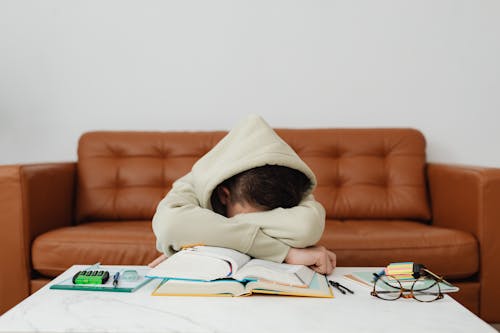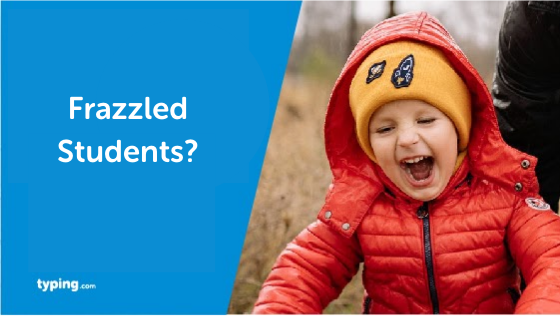Frazzled Students? How To Deal with Burnout
When you think back to the first day of any new school year, it’s pretty easy to paint a picture of what it looked like. Excited students wander the halls with new backpacks, friends reunite, and teachers introduce themselves to whole classrooms full of new students. The first day is generally dedicated to getting to know one another and going over procedures. A little chaotic, but everything is also new and fresh. Moods are elevated and students are excited and motivated to learn.
Fast-forward a few months, and the picture in your mind looks very different. Now your classroom is a bustling place to be. Classrooms are filled with a blend of engaged learners mixed in with peers who are either bored, tired, or frustrated. Every teacher knows just how real student burnout can be for kids (and for you!) and how quickly the excitement of a new school year can turn into copious amounts of stress.
When you think about it, learning new information and skills every single day for seven hours a day for weeks—and then months at a time—can be downright exhausting for anyone who attends school. It’s likely that at some point during the year, some students will experience academic burnout at some point throughout the school year.
Seasoned teachers know that the greatest chance of having a classroom full of struggling students running on fumes typically happens just before the holidays when students start catching a faint glimpse of light at the end of a very long academic tunnel.
But the good news is that there are steps that you can take to prevent burnout in class this school year!
What is Burnout
 The first step in minimizing burnout is to have a clear understanding of what it really is. Academic burnout occurs when students feel exhausted, overwhelmed, and stressed out for an extended duration of time. In essence, after weeks of learning new information, developing new skills, and completing difficult tasks, students may hit a wall and begin to feel depleted in the classroom.
The first step in minimizing burnout is to have a clear understanding of what it really is. Academic burnout occurs when students feel exhausted, overwhelmed, and stressed out for an extended duration of time. In essence, after weeks of learning new information, developing new skills, and completing difficult tasks, students may hit a wall and begin to feel depleted in the classroom.
Some of the most noticeable warning signs your students may exhibit when they’re suffering from school burnout include:
- Self-doubt
- Feeling defeated
- Detachment
- Loss of motivation
- Negative attitude
- Emotional exhaustion
In general, academic burnout in students can look very similar to job burnout in adults. But the best way to know if a student is experiencing academic burnout for sure is to have an open and honest conversation and to offer your support.
How to Deal With Burnout
 Fortunately, there are ways to help manage your students’ stress levels and mitigate academic burnout in the classroom without jeopardizing the quality of education that you’re providing to them.
Fortunately, there are ways to help manage your students’ stress levels and mitigate academic burnout in the classroom without jeopardizing the quality of education that you’re providing to them.
The most effective way to deal with burnout in your students is to make mental health priority and self-care options available in your classroom. Sometimes students just need a moment to relax, so allowing them to take a quick break, to attend to their physical needs like eating, drinking, and using the restroom, and teaching mindfulness practices will go a long way towards dealing with school burnout among your students.
To minimize burnout in the classroom even further, you should also encourage your students to:
- Share their feelings with a trusted adult
- Get plenty of sleep
- Make physical exercise a priority
- Make sure students have enough free time during the day
When dealing with school burnout, it’s important to help your students understand exactly what school burnout is and that it can be fixed so that they never feel alone and hopeless.
How to Avoid Burnout
 Of course, the very best thing you can do for your students this school year is to help them avoid school burnout in the first place. But how do you do this? The easiest way for students to avoid burnout at school is to take care of themselves throughout the school year—being sure not to overdo it in any areas of their lives—and to have reasonable expectations for their academic progress.
Of course, the very best thing you can do for your students this school year is to help them avoid school burnout in the first place. But how do you do this? The easiest way for students to avoid burnout at school is to take care of themselves throughout the school year—being sure not to overdo it in any areas of their lives—and to have reasonable expectations for their academic progress.
As a teacher, you know that little sleep, poor nutrition, dehydration, and having unusually high expectations for themselves can all lead to stress, exhaustion, depression, and other behavioral and mental health issues in students. So reminding them about their physical and emotional well-being and making them active partners in their education can help them avoid school burnout in the first place.
Does it really matter in the long run if a student turns in a paper one day late because they haven’t been sleeping well and they’re exhausted? Probably not! It’s more important for the student’s success for them to be rested and focused. Having stringent rules and penalties around assignments will cause your students to feel overwhelmed and create more anxiety and stress that may eventually lead to the burnout you’re trying to avoid.
Of course, as teachers, you always have administrators to answer to and school policies to follow. But whenever you’re able to, helping your students avoid feeling so overwhelmed with school life will minimize their risk of academic burnout this school year. You can achieve this with more flexibility and fewer demands built into your own classroom policies and procedures.
Making It to Winter Break
 Remember, the risk for academic burnout is particularly high whenever school holidays are looming in the near future. In fact, the time just before the extended winter break is when academic burnout takes place most often.
Remember, the risk for academic burnout is particularly high whenever school holidays are looming in the near future. In fact, the time just before the extended winter break is when academic burnout takes place most often.
But knowledge is power, so knowing that your students are more likely to feel exhausted, overwhelmed, and stressed out this time of year means that you can face the problems of school burnout and even high school depression head-on.
The best plan is to have larger assignments due at least a week or two before students leave for winter break so that you can have some fun and less demanding activities planned just before break.
And the same thing applies when you first return back to school after winter break. Your students need some time to get back into their normal routines, so the first day back to school after winter break is not the best time to jump into a huge project or paper. Instead, consider some after winter break classroom activities that encourage students to talk about their time off, to be creative, and to express themselves in new, re-energizing ways.

